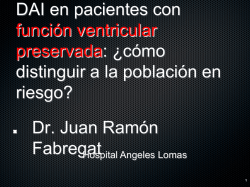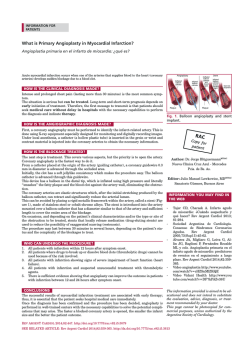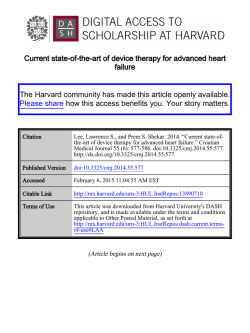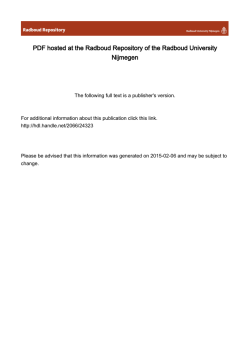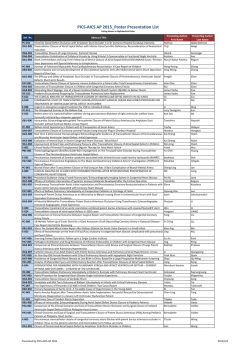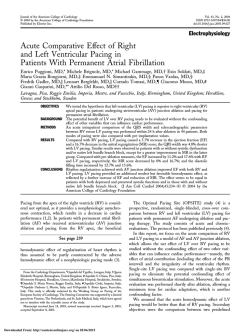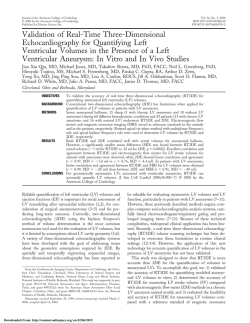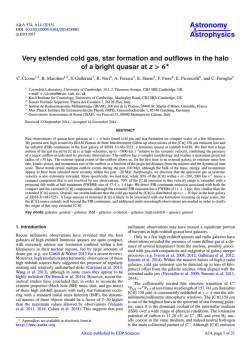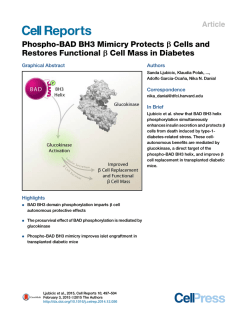
radiofrequency ablation of Frequent Ventricular arrhythmia Guided
BRIEF REPORT Radiofrequency Ablation of Frequent Ventricular Arrhythmia Guided by Array Multielectrode Catheter Ablación por radiofrecuencia de arritmia ventricular frecuente guiada por catéter multielectrodo Array DAMIÁN AZOCAR†, SERGIO J. DUBNERMTSAC, CARLOS D. LABADETMTSAC, CLAUDIO HADIDMTSAC, MARÍA C. VALSECCHI†, AGUSTÍN E. DOMÍNGUEZ ABSTRACT Background and objective: The non-contact mapping system with expandable balloon catheter allows ventricular arrhythmia mapping with few ectopic beats. The aim of this study was to analyze ablation results with this system. Methods: Patients with ventricular arrhythmia were prospectively and consecutively studied with the non-contact mapping system. Results: The study included 10 patients, 8 women, with mean age of 45 years (range: 27 to 65). Arrhythmia origin was right ventricular outflow tract in 8 patients, right ventricular inflow tract in 1 and left ventricular outflow tract in 1. Acute success was obtained in 9/10 patients (90%). Mean follow-up was 6 months (range 1 to 16); 8 patients continued with obliterated arrhythmia without medication and 1 patient required pharmacologic treatment. The only complication was femoral arteriovenous fistula. Conclusions: The non-contact mapping system allows a highly efficient and safe approach of right ventricular arrhythmias. future studies with more patients and comparing with other methods may confirm these results. Key words: Ventricular Tachycardia, - Ventricular Premature Complexes - Catheter Ablation RESUMEN Introducción y objetivo: El sistema de cartografía sin contacto permite el mapeo de arritmias ventriculares, mediante un catéter balón expandible, con escasos latidos ectópicos. El presente estudio se llevó a cabo con el objetivo de analizar los resultados de la ablación con este sistema. Material y métodos: Se estudiaron en forma prospectiva y consecutiva pacientes con arritmia ventricular en los que se utilizó el sistema de cartografía sin contacto. Resultados: Se incluyeron 10 pacientes, 8 mujeres, con una edad media de 45 años (mínima-máxima 27-65). El origen de la arritmia fue el tracto de salida del ventrículo derecho en 8 pacientes, el tracto de entrada del ventrículo derecho en 1 y el tracto de salida del ventrículo izquierdo en 1. Se obtuvo el éxito agudo en 9/10 (90%). El seguimiento medio fue de 6 meses (mínimo 1, máximo 16), 8 pacientes continuaron con abolición de la arritmia sin fármacos y 1 requirió tratamiento farmacológico. La única complicación fue una fístula arteriovenosa femoral. Conclusiones: El sistema de cartografía sin contacto permite el abordaje de arritmias ventriculares de origen derecho con una tasa alta de eficacia y seguridad. Nuevos estudios con una población mayor y que comparen con otras formas de abordaje podrán confirmar estos resultados. Palabras clave: Taquicardia ventricular - Complejos prematuros ventriculares - Ablación por catéter. Abbreviations RFA Radiofrequency ablation BOBreakout EA Earliest activation ECG Electrocardiogram VE Ventricular extrasystoles AAA Antiarrhythmic agents NCMS Non-contact mapping system RVOT Right ventricular outflow tract VT Ventricular tachycardias RV Right ventricle REV ARGENT CARDIOL 2014;82:393-397. http://dx.doi.org/10.7775/rac.v80.i5.3226 Received: 11/30/2013 Accepted: 06/11/20144 Address for reprints: Dr. Damián Azocar - Arenales 2463 - 3-A - (1124) CABA - Tel. 011 4827-4895 - Fax 011 4827- 3654 - e-mail: [email protected] Electrophysiology Service at Clínica y Maternidad Suizo Argentina. Buenos Aires, Argentina MTSAC Full Member of the Argentine Society of Cardiology † To apply as Full Member of the Argentine Society of Cardiology 394 INTRODUCTION Ventricular extrasystoles (VE) and ventricular tachycardias (VT) originating in the right ventricular outflow tract (RVOT) represent the most frequent arrhythmias in patients with normal hearts. Left ventricular outflow tract VT constitute 80% of idiopathic VT. (1) Ventricular tachycardia can be sustained causing syncope or non-sustained and repetitive causing palpitations and other symptoms. The permanent forms may generate ventricular dysfunction. (2) Pharmacologic treatment, especially betablockers and calcium blockers, have limited effectiveness (2550%). Some authors suggest radiofrequency ablation (RFA) as a first line treatment due to the high success rate and low incidence of complications. (3-6) Electroanatomic mapping systems allow activation mapping by acquiring point-by-point electrograms; that is, displacing the catheter in the chamber of interest and acquiring the local electrogram when a VE occurs. This requires the presence of frequent VE and/ or prolonged episodes of VT for the correct arrhythmia mapping. Ablation may fail in cases of infrequent VE, non-inducible arrhythmias or arrhythmias badly tolerated hemodynamically. The non-contact mapping sys- ARGENTINE JOURNAL OF CARDIOLOGY / VOL 82 Nº 5 / OCTOBER 2014 tem (NCMS) consists in an expandable balloon with 64 electrodes that allows the simultaneous recording of more than 3000 virtual unipolar electrograms, mapping arrhythmias with only one beat. (7, 8) The purpose of this study is to analyze RFA results of frequent right ventricular arrhythmia using this novel technique. METHODS The study included prospective, consecutive patients with frequent VE or VT undergoing NCMS. Inclusion criteria were VE > 5000/24 hours or VT refractory to antiarrhythmic agents (AAA), intolerance or patient preference, with suspected right ventricular origin according to the 12-lead electrocardiogram (ECG). The balloon was inserted (Ensite Array. St. Jude Medical, Minnesota, USA) via the femoral vein through a 10 Fr introducer. A 0.035” guidewire was positioned in the pulmonary artery under fluoroscopic guidance and was used to advance the collapsed balloon to the probable site of arrhythmia origin. Heparin was used to maintain an activated coagulation time between 300 and 400 seconds. Once the balloon was positioned in the RV, it was expanded and filled with iodinated contrast media for radiologic visualization (Figure 1). Subsequently, chamber anatomy was obtained with a deflectable catheter. Upon spontaneous arrhythmia occurrence Fig. 1. Expanded balloon catheter in the right ventricular outflow tract filled with iodinated contrast; radiologic left and right anterior oblique views. Fig. 2. Right ventricular outflow tract activation map showing the earliest activation site (EA, earliest activation) and the site where the impulse spreads to the rest of the myocardium (BO, break out). Arrows show the balloon catheter. VENTRICULAR ARRHYTHMIA ABLATION WITH ARRAY CATHETER / Damián Azocar et al. with similar morphology to that of clinical VE/VT, activation mapping guided by unipolar electrograms from the balloon catheter was performed to locate the earliest activation (EA) site, and the breakout (BO) site. This process was repeated with 3 VE to confirm map reproducibility (Figure 2). Isoproterenol or programmed ventricular stimulation was used in patients without spontaneous arrhythmia. Electrocardiographic similarity between VE/VT observed in the laboratory and clinical VE/VT was rigorously controlled. Multielectrode balloon unipolar electrograms allow identification of arrhythmia origin and visualization of electric impulse propagation from the EA to the BO site and the rest of the myocardium. The triggering focus is determined by the QS pattern in unipolar electrograms. Radiofrequency application was directed both to the EA and BO sites with a 4 mm tip non-irrigated catheter (50 watts, 60 ºC). In case of a second arrhythmic focus, a similar procedure was followed. Acute success was defined as sustained spontaneous VE abolition (at least for 30 minutes) and/or non-inducible VE/ VT. Patients were followed up by Holter monitoring every three months. RESULTS Ten patients were included in the study between February 2012 and August 2013. Mean age was 45 years (minimum 27, maximum 65), and 8 patients were women. Only 1 patient had structural cardiomyopathy (non-ischemic dilated cardiomyopathy). All patients presented frequent VE, 2 sustained monomorphic VT and 2 non-sustained VT. Average arrhythmic density was 15,322 VE/24 hours (minimum 5,366, maximum 25,671). Average non-effective AAA per patient was 1.9 (minimum 0, maximum 5). In 2 patients, RFA was the first line treatment (Table 1). The arrhythmic focus was identified in the RVOT in 8 patients and in the right ventricular inflow tract in 1 patient. In the remaining patient, the origin was in the left coronary sinus, and for safety reasons, ablation was not performed. Acute success was achieved in all patients with radiofrequency application [9/9 (100%)] and in all except one of the included patients [9/10 (90%)]. In 3 patients two or more foci were identified, with minimal differences with respect to the clinical arrhythmia. The average procedure time was 193 minutes (minimum 150, maximum 240) and the radioscopy time was 49 minutes (minimum 24, maximum 70). A patient developed femoral arteriovenous fistula at follow-up. During the average 6-month follow-up (minimum 1, maximum 16), 8 patients were asymptomatic, without significant arrhythmia and free from AAA. A patient presented with arrhythmia recurrence one month after ablation, with high arrhythmic density requiring antiarrhythmic treatment, and good response to the same drug (sotalol) that had been ineffective prior to RFA. 395 DISCUSSION The main result of this series is the high success and safety rate of NCMS in this population. Acute success was achieved in 9 out of 10 patients with only one complication (femoral arteriovenous fistula). Ablation was not performed in one patient due to risk of coronary lesion. In the mid-term follow-up, 8 patients controlled the arrhythmia without need of pharmacologic treatment and only one patient with successful acute ablation recurred, though the arrhythmia was adequately controlled with sotalol. Despite this patient´s recurrence, the substrate was modified allowing effective management with previously ineffective drugs. These results point out the importance of selecting patients to use this system, those with RVOT electrocardiographic origin (left bundle branch block, inferior frontal axis, R/S transition in V4) being better candidates. (9) This system has also been used for other right ventricular sites (case number 6, right ventricular inflow tract), right atrium, (10) left atrium (11) and even for the left ventricle. (12) The high effectiveness found in our series of patients agrees with other published studies. (13-15) One limitation of this system is difficulty in guidewire progression to the pulmonary artery (it could be performed in all cases but in some cases it required up to 30 minutes) and the time taken to perform the procedure, as a reduction in these times was observed when comparing the last with the first cases (learning curve). Another limitation is associated to the distance between the balloon catheter and the arrhythmic focus: when the distance between the balloon equator and the focus is greater than 4 cm, reliability of the activation map is lower. To prevent this problem, the 12-lead ECG evaluation is essential when the procedure is planned. Another eventuality is VE mapping originated by balloon contact with the endocardium, which is excluded for being different from the clinical arrhythmia. Despite the considerable balloon size, we have not observed cases of hypotension due to pulmonary flow obstruction. Finally, cost is greater than other mapping systems. CONCLUSION The multielectrode balloon NCMS allows precise identification of right ventricular arrhythmia origin and its approach with a high rate of efficacy and safety. Future studies, with greater number of patients and comparison with antiarrhythmic agents and other forms of mapping may confirm these findings. Conflicts of interest None declared. 396 ARGENTINE JOURNAL OF CARDIOLOGY / VOL 82 Nº 5 / OCTOBER 2014 Table 1. Patients included in the study. Characteristics and outcome Patient nº Age/ gender Arrhythmia Symptoms Nº of non-effective AAA Site Acute Complisuccess cations 1 55 / SMVT and Syncope, 3. Anterolateral Yes woman VE palpitations Amiodarone, caudal RVOT No flecainide, Holter prior to procedure Holter Follow-up after procedure VE VE 60 15 months, 20,666, without SMVT AAA diltiazem 2 54 / VE Palpitations woman 1. Postcranial and Atenolol caudal RVOT Yes No VE VE 4 13,808 without (2 foci) 3 60 / VE, NSVT Palpitations man 5. LVOT, left Atenolol, coronary sinus 14 months, AAA No No VE VE 7 months, 25,671 23,460 with AAA VE VE 0 7 months, amiodarone, propafenone, sotalol, diltiazem 4 39 / SMVT, VE Palpitations Not used Anterior and Yes No posterior caudal woman 6,743, RVOT (2 foci) 5 65 / SMVT VE Palpitations woman 5. Anterolateral Sotalol, flecainide, caudal RVOT without SMVT Yes No atenolol, VE AAA VE 344 6 months 10,565, with sotalol SMVT 80 mg/day propafenone, propranolol 6 29 / VE Palpitations Not used Inferobasal RVIT Yes No woman 7 42 / VE VE 0 19,000 VE woman Palpitations, 1. Posteroseptal HF (EF 41%) Carvedilol caudal RVOT Yes No VE 6 months, without AAA VE 49 22,900 2 months, without AAA Carvedilol for low EF 8 27 / VE Palpitations 9 53 / 1. Lateral RVOT Yes No Bisoprolol woman VE NSVT Palpitations man VE VE 0 7,152 1 month, without AAA 2. High posteroseptal Atenolol, and mid-septal, 21,353, without nebivolol cranial RVOT NSVT AAA Yes No VE VE 5 1 month, (2 foci) 10 28 / woman VE Palpitations 1. Posteroseptal- Amiodarone cranial RVOT Yes Fístula VE arterio- 5,366 venosa VE 0 1 month, without AAA VE: Ventricular extrasystoles. NSVT: Non-sustained ventricular tachycardia. SMVT: Sustained monomorphic ventricular tachycardia. HF: Heart failure. RVOT: Right ventricular outflow tract. RVIT: Right ventricular inflow tract. LVOT: Left ventricular inflow tract. AAA: Antiarrhythmic agents. EF: Ejection fraction. REFERENCES 1. García Civera R, Ruiz Granell R, MorellCabedo S, Martínez León J, Botella Solana S y cols,editores. Electrofisiología cardíaca clínica y ablación. Madrid: McGraw-Hill Interamericana; 1999. p. 327-43. 2. Yarlagadda RK, Iwai S, Stein KM, Markowitz SM, Shah BK, Cheung JW, et al. Reversal of cardiomyopathy in patients with repetitive monomorphic ventricular ectopy originating from the right ventricular outflow tract. Circulation 2005;112:1092-7. http://doi. org/bq86dj 3. Aliot EM, Stevenson WG, Almendral-Garrote JM, Bogun F, Calkins CH, Delacretaz E, et al. EHRA/HRS Expert Consensus on Catheter Ablation of Ventricular Arrhythmias. Heart Rhythm 2009;6:886-933. http://doi.org/c6vhgw 4. Capulzini L, Brugada P, Brugada J, Brugada R. Arrhythmia and right heart disease: from genetic basis to clinical practice. Rev Esp VENTRICULAR ARRHYTHMIA ABLATION WITH ARRAY CATHETER / Damián Azocar et al. Cardiol 2010;63:963-83. http://doi.org/ff5xsr 5. Gant López J, Labadet C, González JL, Retyk E, Cáceres Monié C, Garro H et al. First Argentine Catheter Ablation Registry. Rev Argent Cardiol 2011;79:117-24. 6. Díaz-Infante E, Macías-Gallego A, García-Bolao I. Spanish Catheter Ablation Registry. 9th Report of the Spanish Society of Cardiology Working Group on Electrophysiology and Arrhythmias (2009). Rev Esp Cardiol 2010;63:1329-39. http://doi.org/fjp6xx 7. Ribbing M, Wasmer K, Mönnig G, Kirchhof P, Loh P, Breithardt G, et al. Endocardial mapping of right ventricular outflow tract tachycardia using noncontact activation mapping. J Cardiovasc Electrophysiol 2003;14:602-8. http://doi.org/ctkwrt 8. Schilling RJ, Peters NS, Davies DW. Feasibility of a noncontact catheter for endocardial mapping of human ventricular tachycardia. Circulation 1999;99:2543-52. http://doi.org/vbz 9. Miles WM. Idiopathic ventricular outflow tract tachycardia: where does it originate? J Cardiovasc Electrophysiol 2001;12:536-7. http:// doi.org/cx78j7 10. Wieczorek M, Salili AR, Kaubisch S, Hoeltgen R. Catheter abla- 397 tion of non-sustained focal right atrial tachycardia guided by virtual non-contact electrograms. Europace 2011;13:876-82. http://doi.org/ fj6sv6 11. Cohen TJ, Juang G, Daggubati R. Utility of non-contact threedimensional mapping of the left atrium for ablation of left atrial tachycardia. J Invasive Cardiol 2004;16:100-1. 12. Tsuchiya T. Three-dimensional mapping of cardiac arrhythmias string of pearls. Circ J 2012;76:572-81. http://doi.org/vb2 13. Díaz Infante E, Cózar León R, Borrego I, Maldonado J, Nieto P, Cruz Fernández JM. Ablation of premature ventricular contractions originating in the right ventricular outflow tract using non-contact mapping. Rev Esp Cardiol 2011;64:1198-201. http://doi.org/b583tx 14. Friedman PA, Asirvatham SJ, Grice S, Glikson M, Munger TM, Rea RF, et al. Noncontact mapping to guide ablation of right ventricular outflow tract tachycardia. J Am Coll Cardiol 2002;39:1808-12. 15. Villacastin J, Pérez CN, Moreno J, Álvarez L, Moreno M, Quintana J. Percutaneous epicardial radiofrequency ablation of idiopathic ventricular tachycardia. Rev Esp Cardiol 2005;58:100-4. http://doi. org/chfp8r
© Copyright 2026
